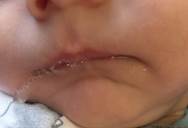Hot Topic Blog - Feeding, Eating, & Drinking
FEEDING INFANTS WITH RECESSED JAW (RETROGNATHIA) AT THE BREAST OR WITH THE BOTTLEBy Allyson Goodwyn-Craine, MS, CCC-SLP, Speech-Language Pathologist specializing in feeding in Oregon, USAJuly 2017 |
|||
|
The discrepancy between maxillary and mandibular alignment often causes the nipple and areola to compress with anterior rotation. Posterior tongue positioning can prohibit the anterior tongue from grasping the breast nipple, as well as the anterior tongue from moving along with the jaw while the posterior tongue moves in a wavelike manner for effective sucking and swallowing. These oral difficulties can cause irritation to the mother’s nipple or tissue trauma. Babies with this problem often have difficulty transitioning off of nipple shields. And, this is sometimes mistaken as characteristic of ankyloglossia (tongue-tie). Many babies have improved latch in a laid-back breast feeding position as gravity assists in moving the tongue and jaw forward.
When bottle supplementation is needed, the Playtex Drop-In Nurser with the Natural Latch nipple provides nice support along the jaw when the bottle is held at a slight angle to allow the lower edge of the nipple to rest along the lower lip. While breast and bottle feeding are different processes mechanically, I typically prefer this bottle/nipple for breast feeding infants to match the gape/latch that compliments oral positioning at the breast. Additionally, infants with small anterior-posterior gaps between the maxilla and mandible (i.e., less than 3mm) typically show no concerns for breathing. However, infants with wide gaps require careful monitoring because the jaw and tongue are pulled back toward the airway. If an infant demonstrates any stress responses in supine (i.e., on the back), such as obstructive airway noises during sleep or the young infant spontaneously moves from the back to side lying, a sleep study and/or airway patency assessment should be done by an otolaryngologist (ENT). The infant’s pediatrician needs to be aware of these concerns when considering a baby’s sleeping position. Some pediatricians may consider elevated or side lying sleep positioners specifically designed for these purposes. These should only be used under the direction of the physician. The majority of infants with slightly recessed lower jaws accommodate for these feeding concerns particularly as they grow. At around 3 to 4 months of age, the infant’s neck elongates and the pharynx deepens as the jaw moves forward with facial growth. This brings the posterior tongue slightly forward. The increased space allows for functional tongue elevation and retraction. At this point most infants can transition to more traditional breast feeding positions.
About Allyson Goodwyn-Craine (allysoncraine@comcast.net) Allyson Goodwyn-Craine (Ally) began her career in 1989. She is a Neuro-Developmental Treatment (NDT) trained Pediatric Speech-Language Pathologist/Feeding Specialist who has worked in Private Practice, Shriner’s Children’s Hospital, Randall Children’s Hospital, and now at Kaiser Sunnyside Medical Center. Ally enjoys helping medically complex babies and toddlers who struggle with feeding challenges from breast, bottle, and tube feedings to transitioning to solid foods. Ally joins infants, toddlers, and their parents in the NICU, NICU Follow-Up Clinic, outpatient treatment, and as a member of the Cleft Palate team. Allyson served as the Clinical Program Director then as the Executive Director of the Artz Center for Developmental Health and Audiology, formerly the Hearing and Speech Institute. During her tenure as Executive Director, the Institute was recognized in the Top 100 Best Non-Profits for which to Work by Oregon Business Magazine and was ranked in the Top 20 Healthcare Non-Profits in Oregon by the Portland Business Journal. Allyson served on the Financial Planning Board of the American Speech-Language-Hearing Association. She is a past president of the Oregon Speech-Language-Hearing Association. She has served on the advisory board and as an adjunct professor at Portland State University for 19 years and is a guest lecturer in Pacific University and University of Oregon graduate programs. She has also traveled nationally and taught as a member of the Education Resources clinical faculty. Allyson was recently awarded the Honors of the Association by the Oregon Speech-Language-Hearing Association. |
|||
 Infants with recessed jaws/retrognathias present with unique feeding challenges and are sometimes misdiagnosed with ankyloglossia or tongue tie. This is of particular concern because in some cases a frenectomy or frenotomy is contraindicated. Although the anterior maxillary and mandibular alignment is impacted, the primary concern is the tongue sitting posteriorly toward the pharynx. In severe cases airway obstruction can occur, but milder cases also require consideration for airway patency. These babes often present with stridor reflective of increased respiratory effort. When paired with a confirmed diagnosis of laryngeal or tracheal malacia, adequate respiratory support needed for sustained energy and coordination for feeding are frequently compromised.
Infants with recessed jaws/retrognathias present with unique feeding challenges and are sometimes misdiagnosed with ankyloglossia or tongue tie. This is of particular concern because in some cases a frenectomy or frenotomy is contraindicated. Although the anterior maxillary and mandibular alignment is impacted, the primary concern is the tongue sitting posteriorly toward the pharynx. In severe cases airway obstruction can occur, but milder cases also require consideration for airway patency. These babes often present with stridor reflective of increased respiratory effort. When paired with a confirmed diagnosis of laryngeal or tracheal malacia, adequate respiratory support needed for sustained energy and coordination for feeding are frequently compromised. Detection of a recessed jaw can be a bit challenging. Infants naturally have a slightly recessed chin/jaw as part of normal development. However, those who present with a gap of 3 mm or more between the anterior upper and lower gum line often struggle at the breast. These infants sometimes have a horizonal crease between the mental region and the lower lip (possibly indicating compensatory overuse of the mentalis muscles). The lower lip often rests tucked behind the upper lip or superior alveolar ridge. Observation at breast and bottle will also reveal increased facial tension particularly along the lateral orbicularis oris often resulting in a narrow latch as the baby tries to compensate for anterior rotation of the nipple between the upper and lower gum lines. In more involved cases the infant struggles with the extension reflex of the tongue needed for latch stability as gravity pulls the back of the tongue posteriorly.
Detection of a recessed jaw can be a bit challenging. Infants naturally have a slightly recessed chin/jaw as part of normal development. However, those who present with a gap of 3 mm or more between the anterior upper and lower gum line often struggle at the breast. These infants sometimes have a horizonal crease between the mental region and the lower lip (possibly indicating compensatory overuse of the mentalis muscles). The lower lip often rests tucked behind the upper lip or superior alveolar ridge. Observation at breast and bottle will also reveal increased facial tension particularly along the lateral orbicularis oris often resulting in a narrow latch as the baby tries to compensate for anterior rotation of the nipple between the upper and lower gum lines. In more involved cases the infant struggles with the extension reflex of the tongue needed for latch stability as gravity pulls the back of the tongue posteriorly.